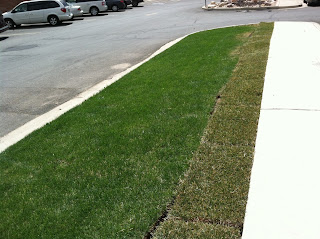 |
| A lawn repair at Lehi city hall. Repairing turf is very water costly and should be avoided durring water restrictions and hot periods. |
Most folks understand that drought causes stress on turf grass and many other plants. What they don't realize is that their weekly ritual of mowing and trimming can be just as damaging to their lawns. When these stresses hit a lawn it needs more water to help it recover from the damage.
So what to do to reduce lawn stress and damage? Try these tips:
- Set the mower height to 3" or more. This gives your grass more sun energy to heal and to send roots down deep to find deep water.
- Drought stressed bluegrass will grow more slowly, so it does not need to be mowed as frequently. As long as you take off one third or less of the grass leaf when mowing, it won't hurt to mow every two weeks. Mowing even less frequently may be possible.
- Keep your blade sharp. A dull blade shreds the grass and requires more water for the grass to recover. If the blade is checked every time the mower is used it never becomes a problem.
- Get a mulch mower and use the mulching feature. The small grass clippings will break down and add carbon to the soil. The carbon will help slow down evaporation so water can go to the lawn instead. Mulch mowing does not create a thatch problem, it actually helps solve it.
If this list looks familier, it should. These are the same recommendations that everyone should be familier with for creating a healthy strong lawn in normal years.
It is also never too late to look at reducing or eliminating turf!
It is also never too late to look at reducing or eliminating turf!
You mention eliminating turf. I live on a corner, across the street from an elementary school, and have 10' wide parking strips. There are trees and turf on the strips. I would love to plant a more desert-appropriate landscape on these strips, but since the entire length of the strips is used to load and unload school children from cars, I don't know if I can get away from turf.
ReplyDeleteHow much of the 10 feet do the kids really use? Could you put hardscape or rock onto the 5 feet nearest the road and make the rest low growing native shrubs and perennials?
ReplyDelete